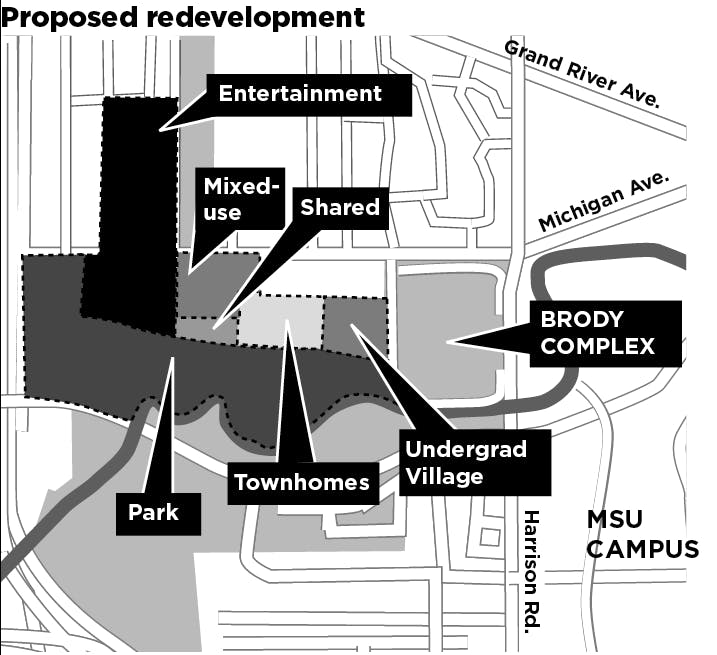Michigan Avenue, the most prominent road connecting East Lansing and the capital city, might be the site of a large-scale redevelopment project that would include student apartments, a shopping center and an outdoor movie theater.
A development group composed of Lansing and East Lansing entrepreneurs and public officials, as well as the Hobbs Black Architects, has created a conceptual plan to redevelop roughly 70 acres of the Michigan Avenue corridor from Clippert Street in Lansing to the abandoned Red Cedar Golf Course property near Brody Complex Neighborhood.
Although the project is in the earliest stages of development and a clear end result isn’t in sight, those involved said it would completely change the image of the two cities.
“This is going to be the million-dollar mile like Chicago has,” Ingham County Drain Commissioner and member of the development team Pat Lindemann said, “This going to be what we’re known for. We’re no longer going to be the orphan child of Ann Arbor or Detroit.”
The group currently has 20 acres of land but still needs approval from both Lansing and East Lansing to move forward with the Capital Gateway Project, which would feature public park land and mixed-use developments.
Managing partner of the development team Chris Jerome said a goal of the proposed plan is to create a more attractive entrance to the university while seamlessly bridging the gap between Lansing and East Lansing.
“You kind of have to sneak into town, and all you look at is a tiny rock that says Michigan State University,” Jerome said. “Our goal is to give MSU a grand entrance the school has deserved.”
Bob Trezise, CEO of Lansing Economic Area Partnership and a leading member of the development team, will present the plans to the East Lansing City Council at Tuesday’s work session with Community and Economic Development Administrator Lori Mullins to give the council an introduction to the project and what the group hopes to accomplish.
For students such as criminal justice sophomore Christina Radak, who lives in student housing near the suggested development, big changes such as the Capital Gateway Project bring forth mixed feelings.
“We still need more student housing, but I wouldn’t like it being that close (to campus),” Radak said. “I like that University Village is on campus yet still somewhat in the country and quiet, and adding a big development would take that feeling away.”
The idea for the project stemmed from a need to improve the water quality in the area of the redevelopment, where some of the most polluted entries into the Red Cedar River and surrounding watershed are located, Lindemann said.
The development team behind the project plans to create what they describe as a hub for student activity and ecological growth by mixing public park land embedded with water treatment features and attractions geared toward students to help solve the Red Cedar pollution problems in a student-friendly setting, Lindemann said.
The next step for the Capital Gateway Project requires approval from Lansing voters on Nov. 6. If it passes, they can begin a more formal approval process, which includes gaining approval to add an additional 48 acres, including the Red Cedar Golf Course.
Mullins said although the project is exciting, it has a long way to go before ground is broken.
Support student media!
Please consider donating to The State News and help fund the future of journalism.
Discussion
Share and discuss “E.L., Lansing officials plan large development” on social media.





